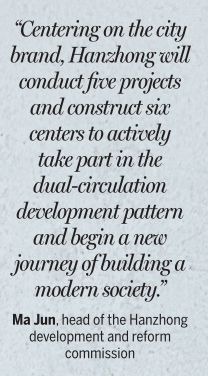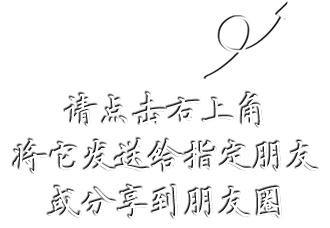

The Hanzhong Binjiang New Area aims to become a livable zone combining tourism, leisure and business, with a good living environment and advanced infrastructure.
As this year is the beginning of the 14th Five-Year Plan (2021-25) period, the government of Hanzhong in Northwest China's Shaanxi province has developed a blueprint for the city's economic and social development over the coming five years, local officials said.
It covers many aspects including building a city brand integrating education and research, healthcare and rehabilitation, tourism and entrepreneurship.
The 14th Five-Year Plan period is crucial for Hanzhong to embark on a path of high-quality development, said Ma Jun, head of the Hanzhong development and reform commission. "Centering on the city brand, Hanzhong will carry out five projects and construct six centers to actively take part in the dual-circulation development pattern and begin a new journey of building a modern society," Ma said.
The five projects aim to upgrade manufacturing and modern agriculture, promote emerging sectors and industrial integration, and improve the development of industries related to people's quality of life such as cultural tourism, educational services, sports, leisure and rehabilitation.
The six centers cover transportation, trade, logistics, education, science, culture, tourism, financial services, green agriculture and traditional Chinese medicine.
"We hope the city's brand and reputation can help gather various types of resources in Hanzhong and make the city into an ideal choice to invest and start new businesses," Ma said. Hanzhong is covered by several national development plans such as the Chengdu-Chongqing dual-city economic circle, and ecological protection and high-quality development of the Yangtze River Economic Belt and the Yellow River basin.
Last year, the city was home to 76 high-tech companies, up from 24 in 2015, and had 29 scientific and technological innovation organizations, up from just one in 2015.
It also boasted a national mass innovation space, the first of its kind in the city.
This year, the city's GDP is expected to increase by 7 percent year-on-year. And the per capita urban and rural disposable incomes are forecast to grow by 9 percent and 10 percent year-on-year respectively, according to the government.
During the next five years, Hanzhong will continue to focus on the green development of industries, such as equipment manufacturing, modern materials, organic food and medicines, to better protect the environment. Industrial and supply chains of these sectors will also be further expanded.
Another work priority has been poverty alleviation, which is considered by the local government to be the most important political mission and the largest project to improve people's livelihood.
Hanzhong has already made remarkable achievements in improving local people's livelihood over the past five years. It added 236,000 jobs in urban areas and helped 524,000 residents out of poverty during that period.
Liuba county, once a poverty-stricken area in northern Hanzhong, has explored a scientific and sustainable development path for the past 10 years.
Since 2011, the county government has stuck to the idea that "clear waters and green mountains are as valuable as mountains of gold and silver", and rejected several investment projects that could largely increase the county's GDP but may cause irreversible damage to the local environment.
It has planted nearly 2.8 million trees and 2 million flowers to increase its forest coverage rate to 91 percent.
With mountains and forests occupying 93.6 percent of its total areas, Liuba has taken full advantage of its environment to develop tourism and green agriculture.
Based on the all-region tourism development concept, the county has built two national 4A tourist attractions, the second-highest level for a tourist attraction in China, as well as an international ski resort, a soccer training center and a series of "back to the 1950s" tourist spots including old streets, schools and bookstores.
Last year, Liuba received 4.2 million visits and generated 2.1 billion yuan ($324 million) in tourism revenue.
So far, the county has 70 percent of the total population involved in the tourism industry and has attracted more than 1,600 migrant workers to return to the county and find jobs.
It has also made the breeding of chickens, pigs, bees and the planting of mushrooms, chestnuts and traditional Chinese medicines pillar industries. All impoverished households have taken part in the development of these industries.
The city's Zhenba county, which is located in the Qinling-Bashan mountainous region, one of China's 14 contiguous areas of extreme poverty, has raised its people out of poverty mainly through promoting health education, building more healthcare facilities and developing family doctor services. All low-income households were covered by basic medical insurance.
With its beautiful natural scenery and profound culture, Hanzhong has a bright future in developing its tourism industry, local officials said.
One of the most attractive scenes is its breathtaking fields of rapeseed flowers.
The city is home to more than 60 square kilometers of rapeseed flower fields that create a splendid landscape.
About 50 observation spots have been designed for tourists and 29 travel routes have been created throughout the city.
As the birthplace of the Han Dynasty (206 BC-AD 220), where the first Han emperor Liu Bang started his long journey to rule the country, Hanzhong has lots of historical relics such as the memorial temple for Zhuge Liang, a renowned military strategist during the Three Kingdoms period (220-280), envoy Zhang Qian's memorial hall and tomb and paper inventor Cai Lun's tomb.
Building scenic spots based on the culture of the Han Dynasty is a priority for the future, said officials from the Hanzhong culture and tourism bureau, so visitors can experience traditional culture in real life-beyond books and historical records.
Other highlights include promoting the integration of tourism and related sectors such as culture, rehabilitation, scientific research and sports. During the 13th Five-Year Plan period (2016-20), Hanzhong received a total of 250 million visits and generated 147.8 billion yuan in tourism revenue.
haonan@chinadaily.com.cn

